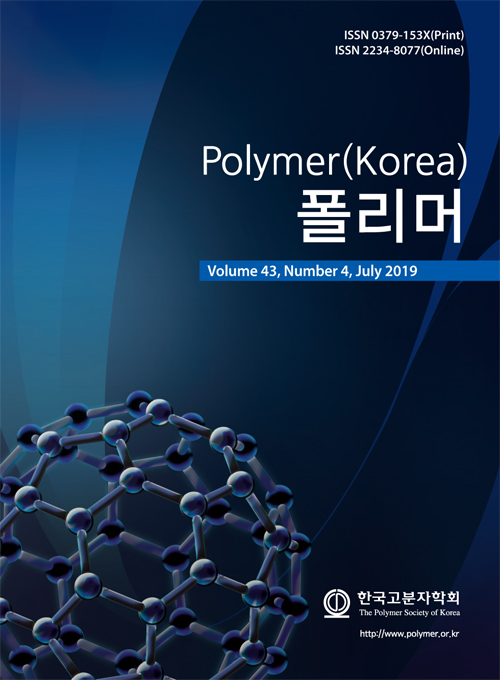- Synthesis and Analysis of Bio-based Polyurethanes with Different Polyester Polyols
*School of Energy, Materials and Chemical Engineering, Korea University of Technology and Education, Cheonan, Chungnam 31253, Korea
**Research Center of Eco-friendly & High Performance Chemical Materials, Cheonan, Chungnam 31253, Korea- 바이오 폴리에스터 폴리올에 의한 폴리우레탄의 합성 및 물성에 대한 연구
*한국기술교육대학교 에너지, 신소재, 화학공학부, **친환경고성능화학소재연구소
Four kinds of bio-based polyester polyols had been synthesized by esterification of two kinds of fatty acids (azelaic acid and adipic acid) and two kinds of diols (isosorbide and 1,3-propanediol (1,3-PD)). After the esterification reaction, the bio-based polyurethanes were synthesized with bio-based polyester polyols and isocyanates (MDI) with a mixing ratio of 1:1.5. The bio-based TPUs were characterized by FTIR, TGA, NMR and GPC. Viscoelastic properties had been tested with strain sweep test mode using rubber process analyzer (RPA), mechanical properties (tensile strength and hardness value) was characterized by UTM and shore A hardness tester. The bio-based polyester polyol which synthesized by adipic acid and 1,3-PD the resulting bio-based TPU showed the best mechanical and viscoelastic properties, when mixed with MDI. The two kinds of bio-based TPUs which contained isosorbide showed narrower molecular weight distribution than the bio-based TPUs containing 1,3-PD. This work provides a new way to develop and research the eco-friendly TPU materials.
2가 산인 azelaic acid, adipic acid와 2가 알코올인 isosorbide, 1,3-propanediol(1,3-PD)를 사용하여 4 가지 바이오 폴리에스터 폴리올을 합성하였다. 합성된 바이오 폴리에스터 폴리올을 4,4'-methylene bis(phenyl isocyanate)(MDI)과 1:1.5의 비율로 혼합하여 바이오 폴리우레탄을 합성하였다. 바이오 폴리우레탄의 구조를 분석하기 위해서 FTIR, TGA, NMR 및 GPC를 사용하였다. 고분자 가공분석기(RPA)의 변형 스윕(strain sweep) 기능을 사용하여 바이오 폴리우레탄의 점탄성을 조사하였다. UTM, Shore A 기기를 사용하여 바이오 폴리우레탄의 인장강도, 경도를 측정하였다. Adipic acid와 1,3-PD에 의한 바이오 폴리에스터 폴리올과 MDI에 의한 바이오 폴리우레탄이 가장 좋은 기계적 물성과 점탄성을 보여주었다. Isosorbide에 의한 2가지 바이오 폴리우레탄이 1,3-PD에 의한 바이오 폴리우레탄보다 더 작은 분자량 분포를 보였다. 본 연구는 미래의 친환경 폴리우레탄 재료의 개발 및 연구에 새로운 방향을 제공한다.
Keywords: bio-polyurethane, isosorbide, synthesis, mechanical properties, viscoelastic properties
- Polymer(Korea) 폴리머
- Frequency : Bimonthly(odd)
ISSN 0379-153X(Print)
ISSN 2234-8077(Online)
Abbr. Polym. Korea - 2023 Impact Factor : 0.4
- Indexed in SCIE
 This Article
This Article
-
2019; 43(4): 595-601
Published online Jul 25, 2019
- 10.7317/pk.2019.43.4.595
- Received on Mar 15, 2019
- Revised on May 22, 2019
- Accepted on May 22, 2019
 Correspondence to
Correspondence to
- Ryong Cho
-
*School of Energy, Materials and Chemical Engineering, Korea University of Technology and Education, Cheonan, Chungnam 31253, Korea
**Research Center of Eco-friendly & High Performance Chemical Materials, Cheonan, Chungnam 31253, Korea - E-mail: urcho@koreatech.ac.kr










 Copyright(c) The Polymer Society of Korea. All right reserved.
Copyright(c) The Polymer Society of Korea. All right reserved.